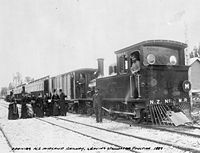- New Zealand Midland Railway Company
-
The New Zealand Midland Railway Company partially constructed the Midland line between Christchurch and Greymouth and the Nelson railway in the South Island. It was one of the few private railway companies in New Zealand, and it did not match the success of the Wellington and Manawatu Railway Company.
History
In the 1880s, New Zealand was in depression and the Government was in no position to make further investment in railways. The East and West Coast and Nelson Railway Act was passed to enable the railway to be built and operated by private enterprise and a deputation of Sir Arthur Dudley Dobson, Alan Scott and C.Y. Fell visited London to interest financiers in promoting a company.
In July 1885 the deputation accepted an offer from a committee that became the New Zealand Midland Railway Company. The company contracted with the Government to build 235 miles (376 km) of railway between Christchurch and Nelson via Brunnerton (later Brunner) within ten years, but with insufficient capital and a London management remote from the realities of railway construction in New Zealand it had little chance of success. The company commenced construction from Brunner, the Nelson line heading up the Grey Valley towards Reefton while the Christchurch line diverged from it at Stillwater. It was not until 1890 that work commenced at the Canterbury end, the contract for the 5.5 miles from Springfield to Pattersons Creek being let to J. & A. Anderson Ltd of Christchurch. The work was to include steel viaducts over the Kowai River and Pattersons Creek.
The company ran out of money and construction ceased in 1895. On the Springfield section only the Kowai bridges and 4.5 miles to track to Otarama were usable as a railway. The foundations for Pattersons Creek viaduct were in place but the steel superstructure still had to be manufactured and erected.
In 1894, after lengthy litigation, the Government seized the company’s assets and completed works on the grounds that the contract had expired with the works incomplete. Legal argument and court actions between the parties ensued and it was not until 1898 that the Public Works Department took over and resumed the works.
Motive power
The company operated mainly 4-4-0 tank locomotives. When it was acquired by the New Zealand Railways Department the first five locomotives, built by Nasmyth Wilson in 1887, were classed La class. The last locomotive was a D class.
See also
Categories:- Rail transport in New Zealand
- Railway companies of New Zealand
Wikimedia Foundation. 2010.

